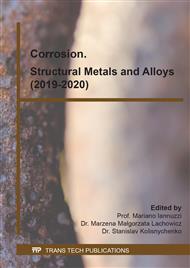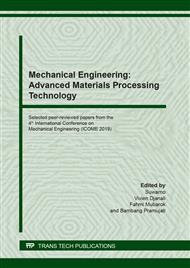p.166
p.172
p.182
p.188
p.196
p.204
p.213
p.218
p.224
The Effect of Citric Acid Concentration on Corrosion Behavior of Austenitic Stainless Steel 316 L
Abstract:
Stainless steel is commonly applied for food processing equipment because of its stability in acid-base conditions. However, corrosion and metal release from the steel can occur in some situations lead to food contamination and decrease the component reliability as well. The objective of the present work is to study the corrosion behavior of austenitic stainless steel 316 L in a water solution containing 9 wt.% NaCl mixed with different concentrations of citric acid. Immersion test and polarization measurements were conducted to quantify the corrosion rate and polarization behaviors of the samples. The result shows that the shape of polarization curves and the corrosion rate are pH dependence. An increased citric acid concentration until the pH value of 4 will enhance the passive film development, but the further increase in acidity aggravates the corrosion attack.
Info:
Periodical:
Pages:
224-228
Citation:
Online since:
October 2020
Authors:
Keywords:
Price:
Сopyright:
© 2020 Trans Tech Publications Ltd. All Rights Reserved
Share:
Citation:



